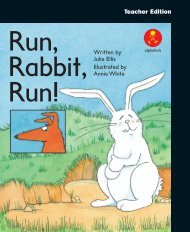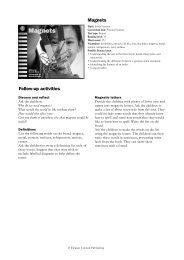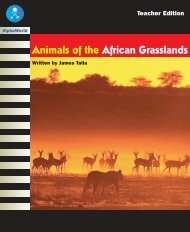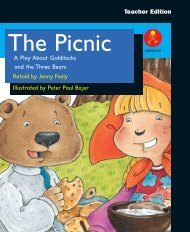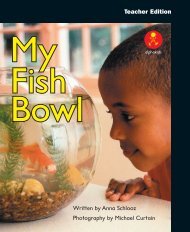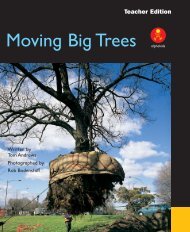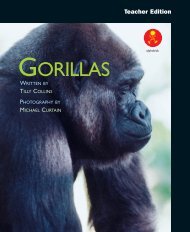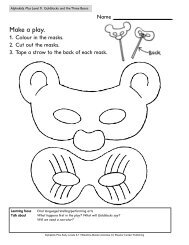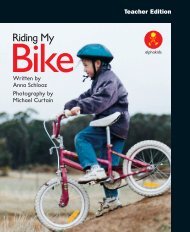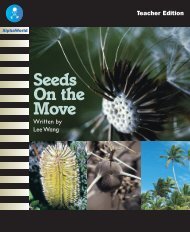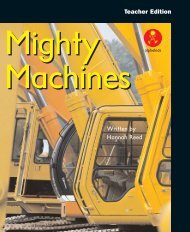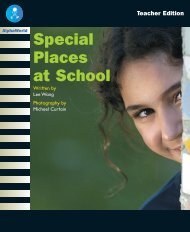Making a Picture
Making a Picture
Making a Picture
You also want an ePaper? Increase the reach of your titles
YUMPU automatically turns print PDFs into web optimized ePapers that Google loves.
Teacher Edition<br />
<strong>Making</strong> a<br />
alphakids<br />
<strong>Picture</strong><br />
Written by<br />
Sara Oldfield<br />
Photography by<br />
Michael Curtain
Published edition<br />
© Eleanor Curtain<br />
Publishing 2004<br />
First published 2004<br />
Apart from any fair dealing for<br />
the purposes of study, research,<br />
criticism or review, as<br />
permitted under the Copyright<br />
Act of Australia, no part of this<br />
book may be reproduced by<br />
any process, or transmitted in<br />
any form, without permission<br />
of the copyright owner. Where<br />
copies of part or the whole of<br />
this book are made under Part<br />
VB of the Copyright Act, the<br />
law requires that records of<br />
such copying be kept and the<br />
copyright owner is entitled to<br />
claim payment.<br />
Developed by<br />
Eleanor Curtain Publishing<br />
Text: Kerrie Shanahan<br />
Consultant: Susan Hill<br />
Designed by<br />
Alexander Stitt<br />
Production by<br />
Publishing Solutions<br />
Printed in China<br />
ISBN 0 7253 3382 0<br />
1 2 3 4 5 6 7 8 9<br />
04 05 06<br />
?<br />
How to use this book<br />
Before reading: Talkthrough<br />
Talk through the book with the children. Encourage<br />
them to predict the text from the cover and the<br />
pictures, and to think about the information they<br />
provide. Direct the children’s attention to aspects of<br />
the text that may challenge them. Support the children<br />
to deal with these challenges by asking the<br />
Talkthrough questions on each page.<br />
During reading: Observe and support<br />
Observe the children as they read. Encourage them<br />
to monitor their own reading as they comprehend<br />
the text. As needed, support the children by helping<br />
them to discover and use reading strategies and cues<br />
to solve problems and respond to reading challenges<br />
that arise in the text. Interruptions to the children’s<br />
reading should be minimal and focused on specified<br />
learning needs.<br />
After reading: Comprehension, returning to<br />
the text, responding and writing links<br />
To further develop children’s understanding of the<br />
text, select from activities found on page 16 and the<br />
inside back cover. These whole text, sentence and word<br />
level activities reinforce the teaching focus of this<br />
book. Assessment ideas are provided to assist with<br />
planning for further teaching.<br />
Text highlights<br />
• The text features a range of colour words.<br />
• The sentence forms: ‘I am making a<br />
picture. I’m using … paper to make …’<br />
• Colour photographs support the text.<br />
Vocabulary<br />
blue, brown, green, paper, picture, pink, white,<br />
yellow
Setting the context<br />
Introduce some books that are illustrated<br />
using paper collage (for example, Hattie and<br />
the Fox by Mem Fox, V is for Vanishing by<br />
Patricia Mullins). Encourage the children to<br />
look at the pictures and talk about how they<br />
might have been made.<br />
Introducing the book<br />
This book tells how three children worked<br />
together to make a picture.<br />
Front cover<br />
What are the children using to make their<br />
picture? What things can you see in their<br />
picture? Do the children look as if they are<br />
cooperating? What makes you think this?<br />
Title page<br />
This page is called the title page. Can you<br />
point to the title of the book? Where is the<br />
author’s name? What else is on the page?
<strong>Making</strong> a <strong>Picture</strong> Pages 2–3<br />
?<br />
Talkthrough<br />
This girl is making a picture. What colour paper is the girl<br />
using? What is she cutting out from the paper?<br />
Observe and support<br />
Can the children use knowledge of initial letters to<br />
support decoding of unknown words?<br />
How did you know that word was picture? What other clues<br />
could you have used? What sound does the letter ‘p’ make<br />
in the word ‘picture’?<br />
2
<strong>Making</strong> a <strong>Picture</strong> Pages 4–5<br />
?<br />
Talkthrough<br />
This boy is making a picture. What is the boy cutting out<br />
from the paper? Do all clouds look like this?<br />
Observe and support<br />
Are the children able to read known text fluently?<br />
Now that you know all the words, can you re-read this so<br />
that it sounds smooth and is easy to understand?<br />
4
<strong>Making</strong> a <strong>Picture</strong> Pages 6–7<br />
?<br />
Talkthrough<br />
What colours is this boy using for his picture? What is he<br />
making with the brown and green paper?<br />
Observe and support<br />
Can the children recognise known words in a text?<br />
What words do you already know on this page? You will be<br />
able to use these words to help work out new ones.<br />
6
<strong>Making</strong> a <strong>Picture</strong> Pages 8–9<br />
?<br />
Talkthrough<br />
This girl is also making a picture. What is she making? What<br />
else did she make for the picture? What other things have<br />
been made for the picture?<br />
Observe and support<br />
Can the children recall events in a text and use this<br />
knowledge to make predictions about future events?<br />
Think about what you have read so far. What things have<br />
already been made for the picture? What else do you think<br />
the children might make for their picture?<br />
8
<strong>Making</strong> a <strong>Picture</strong> Pages 10–11<br />
?<br />
Talkthrough<br />
This boy is making a picture. What is he making out of the<br />
blue and green paper? Yes, that’s right. He is making a<br />
pond.<br />
Observe and support<br />
Do the children check a range of information on the page<br />
to help with problem solving?<br />
Have a look at the pictures. What is the boy making? Yes, it<br />
looks like water but what is the first letter of the word? What<br />
sound does it make? What word starting with the /p/ sound<br />
would make sense here? Re-read the whole sentence to<br />
check that it makes sense.<br />
10
<strong>Making</strong> a <strong>Picture</strong> Pages 12–13<br />
?<br />
Talkthrough<br />
What things have already been made to go in the picture?<br />
What is this boy making for the picture? What colours is he<br />
using?<br />
Observe and support<br />
Can the children use their knowledge of letter-sound<br />
relationships to support their reading?<br />
What letter does that word start with? What sound might it<br />
make? Can you think of a word that starts with /f/ that would<br />
fit there? Does that word make sense?<br />
12
<strong>Making</strong> a <strong>Picture</strong> Pages 14–15<br />
?<br />
Talkthrough<br />
These children are making a picture together.<br />
Do you think they would need to talk to each other to make<br />
their picture? What things would they need to talk about?<br />
When else would they have talked to each other about their<br />
picture?<br />
Observe and support<br />
Can the children recall the sequence of events in a text<br />
after reading?<br />
What part of the picture was made first? What part of the<br />
picture was made next? What was the last part of the picture<br />
to be made?<br />
14
<strong>Making</strong> a <strong>Picture</strong> Page 16<br />
?<br />
Talkthrough<br />
What did the children do when all the pieces for the picture<br />
had been made? Do you like the finished picture?<br />
Can you see any writing on this page? Why do you think the<br />
author has not written anything on this page?<br />
16<br />
After reading<br />
Being a meaning maker<br />
Encourage the children to support their answers with<br />
evidence from the book as they discuss these<br />
comprehension questions:<br />
What is in the picture that the children made?<br />
What colour paper did they use for the flowers?<br />
What colour paper did they use for the pond?<br />
Do you like the picture? Why or why not?<br />
What would be a good name for the picture?
Being a code breaker<br />
Explore the following language features:<br />
• Contractions: I am/I’m.<br />
• Words that rhyme with ‘make’: bake,<br />
cake, fake, lake, rake, sake, take,<br />
wake.<br />
• Sounds and letters: The children<br />
could hold up a finger each time they<br />
hear a word starting with /p/.<br />
Being a text user<br />
Refer to the text when discussing these<br />
questions:<br />
What could this book help you to make?<br />
How could you use this book to get ideas for<br />
making your own picture?<br />
Being a text critic<br />
Could children really make a picture that<br />
looked like this?<br />
Why do you think the author has chosen to<br />
make the children’s picture look the way it<br />
does?<br />
Responding to text<br />
Have the children work in small<br />
groups to plan a picture to make.<br />
Encourage them to work cooperatively to<br />
decide what the picture will show, what<br />
will be in it, what colours they will use<br />
and who will make which parts.<br />
Provide the children with<br />
materials to make their own<br />
‘making a picture’ book. Working in the<br />
same groups, have them make their book<br />
according to the plan they developed in<br />
the previous exercise. Each child would<br />
write the sentences to go with the part of<br />
the picture he or she is making.<br />
Have the children list the colour<br />
words used in their book on a<br />
chart. They could illustrate their chart<br />
with objects that match each colour.<br />
Writing<br />
Innovate on the text by modelling the<br />
writing of a simple book; for example,<br />
making a sandwich, making a car out of<br />
blocks, making a bead necklace. Have the<br />
children draw pictures to go with the<br />
writing.<br />
Assessment<br />
Can the children:<br />
• recall the order in which the children made the elements for their picture?<br />
• say what sound a word starting with, for example, the letter ‘p’ would make?<br />
whole text activity sentence activity word activity
alphakids<br />
<strong>Making</strong> a<br />
<strong>Picture</strong><br />
Teacher<br />
Edition<br />
Other<br />
books<br />
at this<br />
level<br />
Dress-<br />
Written by<br />
Sara Oldfield<br />
Photography by<br />
Michael Curtain<br />
alphakids<br />
ups<br />
Written by<br />
Sara Oldfield<br />
Photography by<br />
Michael Curtain<br />
Topic: Creating artwork<br />
Curriculum link: The Arts<br />
Text type: Recount<br />
Reading level: 6<br />
Word count: 88<br />
High-frequency words: a, am, and, I, I’m, make,<br />
to<br />
Vocabulary: blue, brown, green, paper, picture,<br />
pink, white, yellow<br />
Possible literacy focus<br />
Recalling the steps in a procedure.<br />
Using initial letters to support the decoding of<br />
unknown words.<br />
Mighty<br />
Machines<br />
Written by<br />
Hannah Reed<br />
alphakids<br />
My Farm<br />
Run,<br />
Rabbit,<br />
Run!<br />
alphakids<br />
Written by Jack Hastings<br />
Photography by Michael Curtain<br />
Written by<br />
Julie Ellis<br />
Illustrated by<br />
Annie White<br />
alphakids<br />
Summary<br />
This text describes how three children worked<br />
together to make a picture from coloured paper.<br />
ISBN 0- 7253- 3382- 0<br />
9 780725 333829<br />
alphakids



